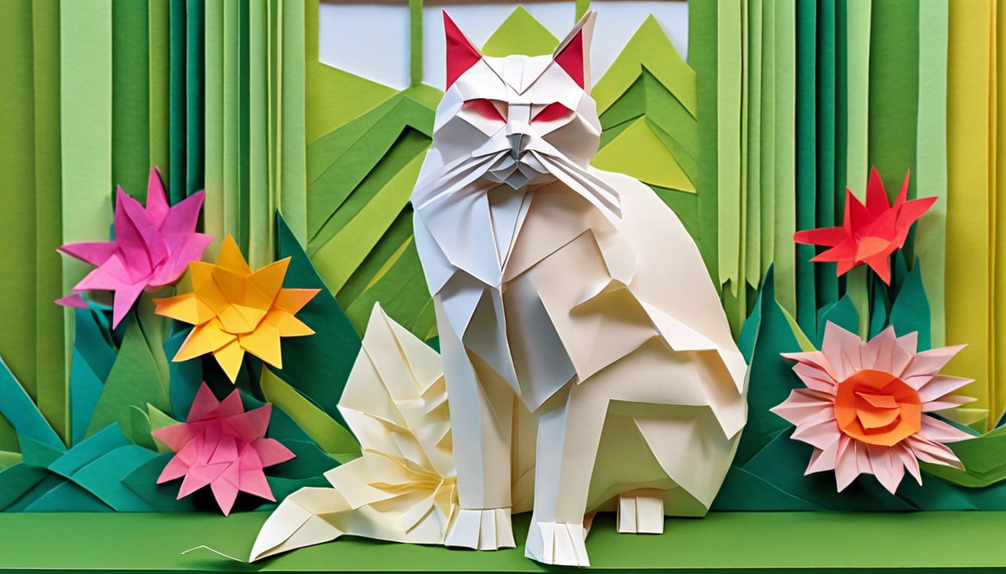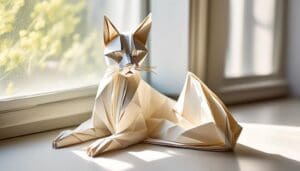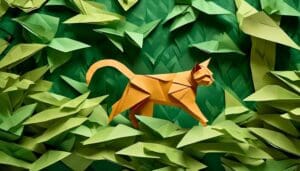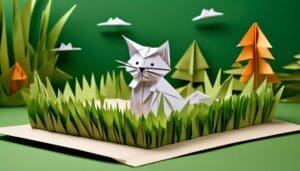As your senior cat gracefully leaps onto the windowsill to bask in the sun, you may notice the hesitation or stiffness in their movements. Just like humans, aging brings changes in mobility for our cats. However, there’s no need to worry – with a few simple adjustments, you can help your senior cat maintain their agility and zest for life.
From creating a stimulating indoor environment to providing tailored care, there are practical steps you can take to ensure your beloved cat stays active and joyful in their golden years.
Key Takeaways
- Regular exercise is essential for maintaining the agility, flexibility, and overall health of senior cats.
- Choosing the right indoor toys that stimulate mental and physical activity is crucial for keeping senior cats engaged and active.
- Creating a cat-friendly environment that accommodates their needs and provides easy access to essential resources is important for their wellbeing.
- Establishing a regular play routine and incorporating interactive feeding methods can contribute to keeping senior cats agile and mentally stimulated.
Importance of Exercise for Senior Cats
Regular exercise is crucial for senior cats to maintain their agility and flexibility as they age. Just like humans, older cats need to stay active to keep their muscles and joints supple.
As your cat ages, it’s important to recognize the significance of exercise in maintaining their overall health and wellbeing. Engaging in regular exercise routines not only helps them stay physically fit but also provides mental stimulation, keeping their minds sharp and alert.
Ensuring that your senior cat receives appropriate exercise can significantly impact their agility and overall quality of life.
As cats age, they may become less inclined to engage in physical activities, but gentle playtime and interactive toys can encourage them to stay active. Feather toys, hide-and-seek games, and puzzle feeders are excellent options for promoting exercise in older cats.
By incorporating these activities into their daily routine, you can help your senior cat maintain a healthy weight and prevent joint stiffness. Indoor play sessions are beneficial for senior cats, as they provide a safe and controlled environment for them to exercise.
Choosing the Right Indoor Toys
When selecting indoor toys for your senior cat, prioritize options that stimulate mental and physical activity to keep them engaged and agile.
To encourage your older cat to play, consider toys designed to simulate hunting and pouncing, such as wand toys or interactive puzzle feeders. These toys provide mental stimulation and help your elderly cat stay fit, promoting a healthy weight.
Opt for softer toys to accommodate any dental issues or reduced agility in aging cats, ensuring their comfort during playtime. Look for toys that are safe and durable to withstand gentle play and chewing.
It’s important to rotate toys regularly to keep the playtime experience fresh and engaging for senior cats, preventing boredom and encouraging activity.
Creating a Cat-Friendly Environment
To create a cat-friendly environment for your senior cat, ensure that warm and draft-free resting places are available, providing comfort and security. Senior cats, much like humans, may experience health issues and behavior changes as they age. It’s important to adapt your home to accommodate their needs, ultimately improving their quality of life.
To help your older cat move around your home easily, you can make some easy changes. Here are some suggestions to make your home safer and more comfortable for your elderly cat:
| Aspect | Description | Benefits |
|---|---|---|
| Resting Places | Provide warm, cozy spots for your cat to rest comfortably | Promotes relaxation and reduces stress |
| Litter Boxes | Ensure easy access to litter boxes on every floor | Helps maintain proper hygiene |
| Food and Water Bowls | Place food and water bowls in multiple accessible locations | Encourages regular hydration and meals |
| Mobility Assistance Tools | Use steps, ramps, or pet stairs to help cats reach high areas | Supports independence and agility |
Establishing a Regular Play Routine
You know how important it’s to keep your senior cat active and engaged, and establishing a regular play routine is key to achieving that.
By choosing the right toys and incorporating interactive playtime, you can help your cat maintain mental and physical exercise.
This dedicated playtime not only keeps your senior cat agile but also strengthens the bond between the two of you.
Toy Selection
Selecting toys for your senior cat’s play routine involves choosing safe and age-appropriate options that encourage movement and mental stimulation. When choosing toys for your older cat, keep in mind the potential health problems they may have, such as dental issues or being less mobile.
Here are some tips to help you select the right toys:
- Consider puzzle feeders to stimulate your cat’s mind and encourage movement.
- Look for toys like feather wands to promote agility and physical activity.
- Choose toys with different textures and sounds, such as crinkle balls, to keep your cat engaged.
Interactive Playtime
When establishing a regular play routine for your senior cat, it’s essential to set aside dedicated time each day for interactive play.
Older cats who are less active can greatly benefit from engaging in playtime activities. Interactive playtime not only helps maintain a healthy level of agility but also has a positive effect on their overall well-being.
By incorporating interactive play into your senior cat’s daily routine, you’re providing them with mental stimulation and physical exercise, which are vital for their happiness. Use a variety of toys, such as wand toys, to keep playtime interesting and mimic hunting behaviors.
Encourage your cat to jump and climb with interactive toys and games to help them stay active and agile indoors. Remember to adjust play activities based on your cat’s preferences and abilities to ensure a fulfilling experience.
Incorporating Interactive Feeding Methods
Incorporating interactive feeding methods can provide mental stimulation and promote physical activity for your senior cat during mealtime. It’s important to keep your older cats healthy and agile, and interactive feeding methods can greatly contribute to achieving this.
Here are some ways to incorporate interactive feeding methods for your aging cat:
- Use food puzzles or interactive feeders to engage your senior cat during mealtime. This not only stimulates their mind but also encourages physical activity.
- Hide small portions of cat food around the house for your cat to find. This mimics their natural hunting instincts and keeps them active.
- Consider using slow feeder bowls to promote slower eating and prevent overeating in older cats. This can help maintain a healthy weight and prevent digestive issues.
Monitoring and Adjusting Activity Levels
As your senior cat’s agility and energy levels may change over time, it’s crucial to keep a close eye on their daily activity. By observing and tracking their movements, you can better understand any shifts in mobility and playfulness.
Adjusting their exercise routine and providing suitable toys and games can help support their mental and physical well-being as they age.
Activity Level Tracking
To help keep your senior cat agile and engaged, carefully monitor and adjust their activity levels, ensuring they receive the appropriate amount of physical and mental stimulation.
Here’s how you can effectively track and adjust your older cat’s activity levels:
- Keep a daily journal of your cat’s playtime and physical activity to ensure they’re getting enough exercise.
- Adjust playtime to suit your cat’s energy levels, avoiding high-impact activities that may cause discomfort.
- Use interactive toys and puzzles to provide mental stimulation and maintain your cat’s agility.
Exercise Routine Changes
As your senior cat’s needs change, it’s important to adapt their exercise routine to ensure they receive the right amount of physical and mental stimulation. Older cats tend to experience changing needs as they age, and it’s crucial to keep your cats well-being in mind. To help reduce the strain on their aging bodies, consider modifying their exercise regimen.
Here’s a helpful guide to keep your senior cat active and healthy:
| Exercise Routine Changes | Benefits |
|---|---|
| Monitor activity levels | Tailor exercises to their needs |
| Low-impact exercises | Engage them without causing discomfort |
| Watch for signs of fatigue | Make necessary adjustments |
| Regularly assess routine | Ensure it aligns with their capabilities |
Seeking Veterinary Guidance for Exercise Plans
Before formulating an exercise plan for your senior cat, it’s essential to seek personalized guidance from a veterinarian to ensure it’s safe and beneficial for your cat’s specific needs. Seeking veterinary guidance for exercise plans is crucial as your cat gets older and may have special needs.
Here are a few reasons why consulting with a veterinarian is important:
- Assessment of Health and Mobility: A veterinarian can assess your cat’s overall health, mobility, and any age-related conditions that may impact their ability to exercise safely.
- Tailored Exercise Plans: Veterinary input can help tailor an exercise plan that addresses any age-related limitations or health conditions your senior cat may have.
- Regular Check-ins: Regular check-ins with a veterinarian can ensure that your senior cat’s exercise plan is adjusted as needed to accommodate any changes in health or mobility. This proactive approach can help prevent injury and promote overall well-being for your senior cat.
Frequently Asked Questions
Do Older Cats Like to Stay Indoors?
Yes, they often prefer the comfort of familiar surroundings as they age. It’s essential to create an indoor environment that promotes their agility, mental stimulation, and physical activity.
How Do I Keep My Senior Cat Entertained?
To keep your senior cat entertained, try interactive toys, puzzle feeders, and gentle play sessions. Rotate toys regularly to keep things interesting. Your cat will appreciate the mental stimulation and bonding time with you.
Why Is My Elderly Indoor Cat Trying to Get Outside?
It’s natural for your elderly indoor cat to want to go outside. Their curiosity and need for mental and physical stimulation may drive this behavior. Ensuring a stimulating indoor environment can help satisfy their desires.
How Active Should a 12 Year Old Cat Be?
As a 12-year-old cat, you should engage in gentle play activities to maintain physical and mental fitness. Consider using interactive toys and puzzles to stimulate your mind. Encourage climbing to maintain agility and stamina.




